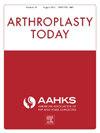Spinal Anesthesia in Total Hip Arthroplasty is Associated With Improved Outcomes in the American Joint Replacement Registry Population
IF 1.5
Q3 ORTHOPEDICS
引用次数: 0
Abstract
Background
Despite previous studies showing benefits of spinal anesthesia (SA) for patients undergoing elective total hip arthroplasty (THA), most THA procedures throughout the United States still utilize general anesthesia (GA). Using the American Joint Replacement Registry data, our study explored outcome difference for patients undergoing THA administered SA vs GA.
Methods
All available THAs were identified using American Joint Replacement Registry data from 2017 to 2020. THA patients were categorized into 2 cohorts by anesthesia type. Demographics, hospital characteristics, and comorbidities were documented for each patient. Outcomes included operative time, length of stay, 30- and 90-day readmission, and 90-day all-cause revision. Chi-square analysis was used to assess categorical variables while multivariable regression analyzed the association between anesthesia type and outcomes of interest.
Results
A total of 217,124 THAs were identified, including 119,425 (55.0%) patients who received GA and 97,699 (45.0%) patients who received SA. Multivariable regression showed that SA was associated with a decreased risk of hospital length of stay >3 days (adjusted odds ratio [aOR] 0.4, 95% confidence interval [CI]: 0.34-0.36, P < .0001) and a lower likelihood of prolonged operative time (aOR 0.8, 95% CI: 0.79-0.82, P < .0001). Additionally, patients who received SA had lower rates of 90-day readmission (aOR 0.7, 95% CI: 0.67-0.78, P < .0001) and a decreased risk of 90-day all-cause revision (aOR 0.5, 95% CI: 0.47-0.54, P < .0001).
Conclusions
Patients receiving SA during THA had shorter operative time, reduced length of stay, and decreased rates of readmission and revision compared to patients who received GA. These findings add to the growing body of literature supporting the benefits of SA over GA for THA patients.
全髋关节置换术中的脊髓麻醉与美国关节置换注册人口的疗效改善有关
背景尽管之前的研究显示脊髓麻醉(SA)对接受择期全髋关节置换术(THA)的患者有好处,但美国的大多数 THA 手术仍采用全身麻醉(GA)。我们的研究利用美国关节置换登记处的数据,探讨了接受椎管内麻醉与全身麻醉的全髋关节置换术患者的预后差异。方法利用美国关节置换登记处 2017 年至 2020 年的数据确定了所有可用的全髋关节置换术。根据麻醉类型将 THA 患者分为 2 个队列。记录了每位患者的人口统计学特征、医院特征和合并症。研究结果包括手术时间、住院时间、30 天和 90 天再入院率以及 90 天全因翻修率。采用卡方分析法评估分类变量,同时采用多变量回归法分析麻醉类型与相关结果之间的关系。结果 共确定了217124例 THAs,其中119425例(55.0%)患者接受了GA,97699例(45.0%)患者接受了SA。多变量回归显示,SA 与住院时间减少 3 天的风险相关(调整后的几率比 [aOR] 0.4,95% 置信区间 [CI]:0.34-0.36,P<0.05):0.34-0.36,P <.0001)和手术时间延长的可能性降低(aOR 0.8,95% 置信区间:0.79-0.82,P <.0001)。此外,接受 SA 治疗的患者 90 天再入院率较低(aOR 0.7,95% CI:0.67-0.78,P < .0001),90 天全因翻修风险较低(aOR 0.5,95% CI:0.47-0.54,P < .0001)。结论与接受 GA 治疗的患者相比,在 THA 期间接受 SA 治疗的患者手术时间更短、住院时间更短、再入院率和翻修率更低。越来越多的文献支持在 THA 患者中使用 SA 术比使用 GA 术更有益处,这些研究结果是对这一观点的进一步补充。
本文章由计算机程序翻译,如有差异,请以英文原文为准。
求助全文
约1分钟内获得全文
求助全文
来源期刊

Arthroplasty Today
Medicine-Surgery
CiteScore
2.90
自引率
0.00%
发文量
258
审稿时长
40 weeks
期刊介绍:
Arthroplasty Today is a companion journal to the Journal of Arthroplasty. The journal Arthroplasty Today brings together the clinical and scientific foundations for joint replacement of the hip and knee in an open-access, online format. Arthroplasty Today solicits manuscripts of the highest quality from all areas of scientific endeavor that relate to joint replacement or the treatment of its complications, including those dealing with patient outcomes, economic and policy issues, prosthetic design, biomechanics, biomaterials, and biologic response to arthroplasty. The journal focuses on case reports. It is the purpose of Arthroplasty Today to present material to practicing orthopaedic surgeons that will keep them abreast of developments in the field, prove useful in the care of patients, and aid in understanding the scientific foundation of this subspecialty area of joint replacement. The international members of the Editorial Board provide a worldwide perspective for the journal''s area of interest. Their participation ensures that each issue of Arthroplasty Today provides the reader with timely, peer-reviewed articles of the highest quality.
 求助内容:
求助内容: 应助结果提醒方式:
应助结果提醒方式:


